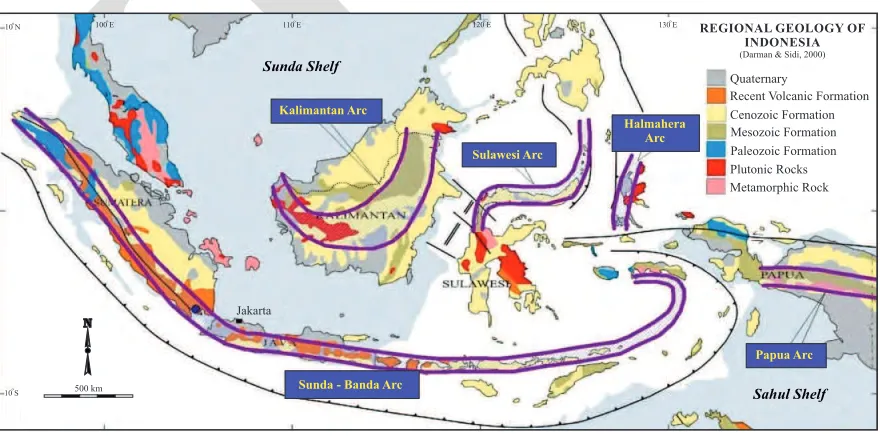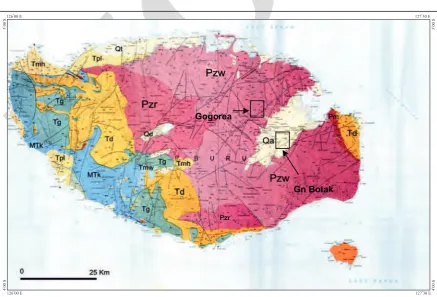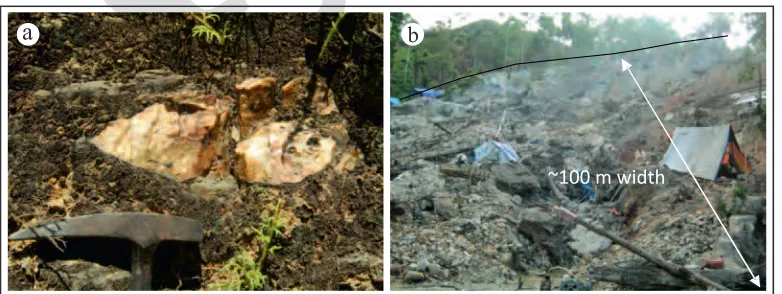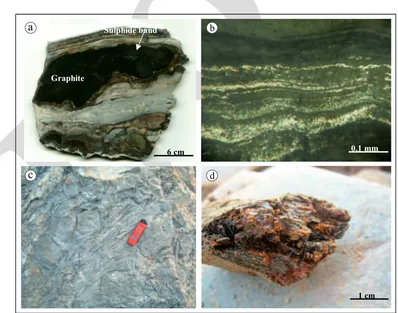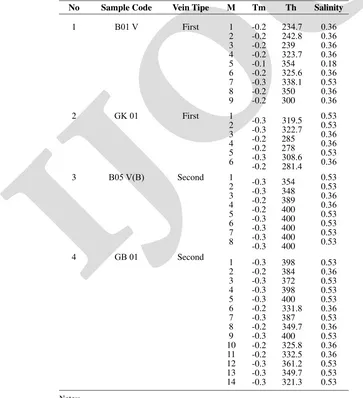IJOG
9
INDONESIAN JOURNAL ON GEOSCIENCE
Geological Agency
Ministry of Energy and Mineral Resources
Journal homepage: h�p://ijog.bgl.esdm.go.id ISSN 2355-9314 (Print), e-ISSN 2355-9306 (Online) Indonesian Journal on Geoscience Vol. 1 No. 1 April 2014: 9-19
Some Key Features and Possible Origin of the Metamorphic
Rock-Hosted Gold Mineralization in Buru Island, Indonesia
Arifudin Idrus1, Sukmandaru Prihatmoko2, Hill. Gendoet Hartono3, Fadlin Idrus3, Ernowo4, Franklin4, Moetamar4, and Iwan Setiawan5
1Geological Engineering Department, Gadjah Mada University, Yogyakarta 2PT. AGC Indonesia, Jakarta
3Geological Engineering Department, STTNas Yogyakarta 4Center for Geological Resources, Geological Agency, Bandung
5Geotechnology Research Centre, LIPI, Bandung
*Corresponding author: [email protected]
Manuscript received: February 10, 2014, revised: March 10, 2014, approved: March 28, 2014
Abstract - This paper discusses characteristics of some key features of the primary Buru gold deposit as a tool for a better understanding of the deposit genesis. Currently, about 105,000 artisanal and small-scale gold miners (ASGM)
are operating in two main localities, i.e. Gogorea and Gunung Botak by digging pits/shafts following gold-bearing
quartz vein orientation. The gold extraction uses mercury (amalgamation) and cyanide processing. The field study identifies two types/generations of quartz veins namely (1) Early quartz veins which are segmented, sigmoidal, dis
-continous, and parallel to the foliation of host rock. The quartz vein is lack of sulfides, weak mineralized, crystalline, relatively clear, and maybe poor in gold, and (2) Quartz veins occurred within a ‘mineralized zone’ of about 100 m in width and ~1,000 m in length. The gold mineralization is strongly overprinted by an argillic alteration zone. The mineralization-alteration zone is probably parallel to the mica schist foliation and strongly controlled by N-S or NE-SW-trending structures. The gold-bearing quartz veins are characterized by banded texture particularly colloform following host rock foliation and sulphide banding, brecciated, and rare bladed-like texture. The alteration types consist of propylitic (chlorite, calcite, sericite), argillic, and carbonation represented by graphite banding and carbon flakes. The ore mineralization is characterized by pyrite, native gold, pyrrhotite, and arsenopyrite. Cinnabar, stibnite, chalcopyrite, galena, and sphalerite are rare or maybe absent. In general, sulphide minerals are rare (<3%). Fifteen rock samples were collected in Wamsaid area for geochemical assaying for Au, Ag, As, Sb, Hg, Cu, Pb, and Zn. Eleven of fifteen samples yielded more than 1.00 g/t Au, in which six of them are in excess of 3.00 g/t Au. It can be noted that all high-grade samples are originally or containing limonitic materials, that suggest the role of supergene enrichment. Interestingly, most of the high-grade samples contain also high grade As (up to 991ppm), Sb (up to 885 ppm), and Hg (up to 75 ppm). Fluid inclusions in both quartz vein types consist of four phases including L-rich, V-rich, L-V-rich, and L1-L2-V (CO2)-rich phases. Mineralizing hydrothermal fluid is typified by CO2-rich fluid, moderate temperature of 300 - 400 ºC and a typical low salinity (0.36 to 0.54 wt.% NaCl eq). Based on those key features, gold mineraliza
-tion in Buru Island meets the characteristics of LS epithermal or orogenic gold deposit types; however, it tends to be fitter with orogenic gold deposit rather than another type.
Keywords: gold mineralization, metamorphic rock, Buru Island, Indonesia
Introduction
Gold exploration activities in Indonesia are recently not only focused along volcanic belts, but also starting to shift along metamorphic terrains. Some known significant gold-(copper) hydrother
-mal deposits hosted by volcanic rocks were found
in last few decades including epithermal type at Pongkor in West Java (e.g. Basuki et al., 1994), Gosowong in Halmahera Island (e.g. Gemmell,
2007), skarn type at Erstberg, Big Gossan, Kuc
-ing Liar, Deep Ore Zone (DOZ) in Papua (e.g. Mertig et al., 1994), and porphyry type at Batu
Hijau in Sumbawa Island (e.g. Meldrum et al.,
IJOG
Indonesian Journal on Geoscience, Vol. 1 No. 1 April 2014: 9-19
1994; Idrus et al., 2007). Many current discover
-ies of placer (secondary) and primary gold min -eralization genetically occur in association with
metamorphic rocks, for instance, Awak Mas me
-sothermal (Querubin & Walters, 2011), Poboya LS-epithermal (Wajdi et al., 2011) and Bombana orogenic gold deposits in Sulawesi (Idrus & Pri
-hatmoko, 2011). Gold-bearing quartz veins are
also recognized in Derewo metamorphic belt at
northern and northwestern part of Central Range Papua. Some exploration reports categorized the
Derewo metamorphic-related quartz veins into mesothermal gold deposit type.
The latest development, in January 2012, local people in Buru Island discovered gold nuggets in Gunung Botak and Gogorea areas, Wamsait Villiage, Waeapo District, Buru Regency, Ma
-luku Province, Indonesia. Until November 2012,
about 100,000 artisanal and small-scale miners
have operated in Gunung Botak and about 5,000 traditional miners operating in Gogorea area. The genetic type of the Buru Island gold mineralization is still debatable. This paper is written on the basis of a short site visit and preliminary study of the
primary gold mineralization to discuss some ob-served geological characteristics and limited
labo-ratory analyses of restricted samples. This aims to a better understanding of the possible genesis of the metamorphic-hosted gold mineralization.
Regional geology
Buru is the third largest island after Seram and Halmahera within Maluku Islands of Indonesia. The island belongs to Maluku Province and in -cludes the Buru and South Buru Regencies. Buru is shaped as an oval elongated form from west to east. The maximum length is about 130 km from east to west and 90 km from north to south. The highest point on the island (2,700 m) is the peak of Mount Kapalatmada. The relief is mostly mountainous, especially in central and western parts. With the length of about 80 km, Apo is the largest river of Buru. It flows nearly straight to the north-east and empties into the Kayeli Bay.
Buru Island constitutes one of the islands in the Banda Islands, Central Maluku, Indonesia. Geologically, it is part of the outer Banda Arc of non-volcanics (Guntoro, 2000). Buru Island pro -vides a key example of the processes involved in mountain building and continental collision. So far, it is generally accepted that Buru Island is a microcontinent derived from Australian continent that had been detached during the Mesozoic. The emplacement of Buru Island to the present posi -tion is still subject to debate. Figure 1 shows that presently Buru Island is tectonically situated at the fore arc of western-eastern trending Sunda-Banda magmatic arc, which is terminated in the east at the Banda Islands (Carlile and Mitchell, 1994).
Figure 1. Regional geological map of Indonesia. Some major gold-copper mineralizations are indicated. Major Tertiary magmatic-arcs are also shown (Carlile and Mitchell, 1994). Buru Island is part of outer Banda arc (nonvolcanic) situated at the fore arc of the western-eastern trending Tertiary-Quaternary Sunda-Banda magmatic arc.
Quaternary
Recent Volcanic Formation Cenozoic Formation Mesozoic Formation Paleozoic Formation Plutonic Rocks Metamorphic Rock
REGIONAL GEOLOGY OF INDONESIA (Darman & Sidi, 2000)
Papua Arc
Sunda - Banda Arc
Sulawesi Arc
Halmahera Arc Kalimantan Arc
500 km
o
10 N
o
10 S
o
100 E 110 E o o
120 E o
130 E
Jakarta
Sunda Shelf
IJOG
Some Key Features and Possible Origin of the Metamorphic Rock-Hosted Gold Mineralizationin Buru Island, Indonesia (A. Idrus et al.)
11
Geology of Buru Island
The description of geological framework of Buru Island is based on Geological Map of Buru Island sheet, Moluccas (Tjokrosapoetro et al., 1993). Stratigraphically, the lithologies of the Buru Island from the oldest to the youngest are successively occupied by Wahlua Complex (Pzw), Rana Complex (Pzr), Ghegan Formation (Tg), Dalam Formation (Td), Tm (Mefa Forma -tion), Kuma Formation (MTk), Wakatin Forma -tion (Tmw), Hotong Forma-tion (Tmh), Leko Formation (Tpl), and Qa (Alluvium). The Wahlua Complex (Pzw) mostly comprises moderate grade metamorphic rocks ranging from green schist to lower amphibolites, phyllite, slate, meta-arkosic sandstone, quartzite, and marble. The complex is widely distributed in the eastern part of the Buru Island (Figure 2). The Rana Complex (Pzr) occupies the central part of the island around the Rana Lake. This rock complex is composed of phyllite, slate, meta-arkose, meta-greywacke, and marble. The Ghegan Formation (Tg), Dalam For
-mation (Td), Kuma For-mation (MTk), Wakatin Formation (Tmw), Hotong Formation (Tmh), and Leko Formation (Tpl) are mostly characterized by carbonaceous clastic sediments and widely extended in the western part of the Buru Island. The Mefa Formation (Pm) is typified by basaltic lava and tuff and the presence of pillow structure and diabase intrusion in the easternmost of the island. Quaternary sediments are represented by lake deposit in Rana (Qd), reef limestone (Qt), and Quartenary alluvial deposit (Qa). Qa is characterized by fragments, gravel, sand, silt, and mud, which are distributed within the valley of rivers and along the stream. Studied area is situ-ated in the Wahlua metamorphic complex (Figure 2), which is of Upper Carboniferous until Lower Permian in age.
Research methods
This preliminary study has been carried out
through several approaches including desk study,
Figure 2. Geological map of Buru Island (modified from Tjokrosapoetro et al., 1993). Gunung Botak and Gogorea are oc
-cupied by Pzw (Wahlua metamorphic rock complex). Note: Brief description of rock formation abbreviation is mentioned in Chapter 3 (Geology of Buru Island).
127 30 E 126 00 E
3 00 S 3 00 S
4 00 S 4 00 S
127 30 E 126 00 E
o o
o o
o o
o o
Gogorea
IJOG
Indonesian Journal on Geoscience, Vol. 1 No. 1 April 2014: 9-19
fieldwork, and sampling for laboratory analysis. There is no previous detailed study in the area that was focused specifically on the primary
gold mineralization. Host rocks and gold-bearing quartz vein samples were taken, and
petrograpi-cally analyzed for hydrothermal alteration and ore mineralogies at Department of Geological Engineering, Gadjah Mada University. Rock geo
-chemical assays were conducted in ITS labora
-tory, Jakarta and AAS laboratory of Georesources Research Center, Bandung. A single ICP-MS analysis was done by Prof. Victor Okrugin in Kamchatka, Russia. Fluid inclusion within quartz veins from various stages was microthermometri
-cally analyzed by LINKAM THMS600 heating and freezing stage at Geotechnology Research Centre, LIPI Bandung.
Results and discussion
Ore Deposit Geology
Lithologically, primary gold mineralization in Buru Island is hosted by mica schist of Carbon
-iferrous to Permian Wahlua Metamorphic Com
-plex (Pzw). The same case has been recognized in Bombana gold deposit which is also hosted by
Carboniferrous-Permian Pompangeo Metamor
-phic Complex (PMC) (Idrus and Prihatmoko, 2011). PMC is typically characterized by mica
schist. Hence, it is important to note that the rock
characteristics and the ages of both Wahlua Com
-plex and PMC are exactly the same. Petrographic study exhibits that mica schist in Buru Island is
composed of muscovite, chlorite, and sericite suggesting a green schist facies (Yardley, 1989). Gold mineralization in Buru occurs in the form of quartz veins/veinlets/reef. In general, there are two types/generations of quartz veins namely (1) Quartz veins which are segmented, sigmoidal, discontinous, and parallel to the foliation of the metamorphic rocks. The vein distribution and pat-tern is intimately controlled by foliation orienta -tion in the area. Mineralogically, the quartz vein is lack of sulfides, weak mineralized, crystalline, relatively clear, and maybe poor in gold (Figure 3a); (2) Quartz veins occurs within a ‘mineral -ized zone’ of about 100 m in width and ~1,000 m in length (Figure 3b). Gold mineralization is strongly overprinted with argillic alteration zone (Figure 3b). Although it is still lack of field data, the mineralization-alteration zone is probably parallel to the mica schist foliation. According to field data and Buru geological map (cf. Tjok -rosapoetro et al., 1993), it is interpreted that gold mineralization may be strongly controlled by N-S or NE-SW-trending geological structures (strike-slip faults?) (Figure 2). Artisanal and small scale gold mining (ASGM) activities are currently concentrated along the structural-controlled mineralization zone.
Ore Textures
Field and handspecimen observations indicate that gold-bearing quartz veins are characterized by vuggy, banded texture particularly colloform fol -lowing host rock foliation, and sulphide banding (Figures 4a and b) and brecciated texture (Figure
Figure 3. Photographs of quartz veins. (a) The first quartz vein type with typical sigmoidal structure, and (b) Second quartz vein in Gunung Botak associated with mineralization-argillic alteration zone (~100 m width and ~1,000 m length). Artisanal and small scale mining (ASGM) activities are concentrated along the mineralization zone (second quartz vein type).
~100 m width
IJOG
Some Key Features and Possible Origin of the Metamorphic Rock-Hosted Gold Mineralizationin Buru Island, Indonesia (A. Idrus et al.)
13 4c). Bladed-like texture is also observed, but it is
rare (Figure 4d). Those textures more likely devel -oped in classic LS epithermal vein deposits. How -ever, a few anomalies from shallow gold systems in the Yilgarn Block of Western Australia are no -table. Comb, cockade, crustiform, and colloform textures at the Racetrack deposit, Australia, de -posited from CO2-poor fluids in lower greenschist facies rocks are also recognized (Gebre-Mariam et al., 1993). Similar textures at the Wiluna gold deposits in subgreenschist facies rocks, as well as δ18Oquartz measurements as light as 6 - 7 per ml, provide some of the strongest evidence of meteoric water involvement in some of the ‘mesothermal’ hydrothermal systems (Hagemann et al., 1992, 1994). Although it is uncommon, pseudomorph bladed carbonate texture could be present in orogenic quartz veins/reefs if the hydrothermal fluids forming the ore deposit have the right phase separation condition (personal communication, Richard J. Goldfarb, 2011).
Alteration and Ore Mineralogy
Hydrothermal alteration style is identified ac -cording to the field observation and petrographic analysis. As outlined above, the gold mineraliza-tion zone is intimately associated with argillic-altered mica schist delineating an obvious high Au grade zone of about 100 m width and 1,000 m length. Clay mineral types characterizing argillic alteration zone are unknown. The petrographic analysis shows host rock is also propyllitically altered typified by the presence of chlorite, cal -cite, and sericite. Carbonation alteration style represented by graphite banding (Figure 4a) and carbon flakes (Figure 5a,b) is a typical alteration type occurring in metamorphic-related hydrother-mal ore deposits.
The field observation and ore microscopic analysis indicate that the ore mineralization is characterized by pyrite, native gold (Figure 6a & b), pyrrhotite, and arsenopyrite (Figure 6c). However, cinnabar, stibnite, chalcopyrite,
ga-Figure 4. Photographs of gold-bearing quartz veins. (a) Handspecimen of the second quartz vein type with banding (collo
-form texture quartz vein following foliation), graphite, and sulphide banding, (b) The microphotograph of graphite banding (dark) and sulphide banding (light) identified as arsenopyrite with white-grey colour and strong anisotropy, (c) Outcrop of brecciated quartz vein and silicified mica schist in Gunung Botak, and (d) Handspecimen of highly oxidized/limonitic quartz vein with bladed-like texture. indicating a boiling condition.
Sulphide band
Graphite
6 cm 0.1 mm
1 cm
a b
IJOG
Indonesian Journal on Geoscience, Vol. 1 No. 1 April 2014: 9-19
lena, and sphalerite are rare or maybe absent. In
general, sulphide minerals are rare (<3%). This is consistent with mineralogical features of other
metamorphic rock-hosted gold mineralizations
worldwide (cf. Groves et al., 1998, 2003).
Ore Chemistry
Fifteen rock samples were collected in Wamsaid area for geochemical assaying in ITS Laboratory, Jakarta, for Au, Ag, As, Sb, Hg, Cu, Pb, and Zn. The samples were collected
in various places and sample types including
outcrops, float/ boulders, and dump material of the traditional miners. Table 1 shows the rock sample description and assay results. Eleven of fifteen samples yielded more than 1.00 g/t Au, in which six of them are in excess of 3.00 g/t Au. It can be noted that all high-grade samples are originally or containing limonitic materials, that suggest the role of supergene enrichment. Interestingly, most of the high-grade samples contain also high grade As (up to 991 ppm), Sb (up to 885 ppm), and Hg (up to 75 ppm). A single ICP-MS analysis by Prof Okrugin (Kamchatka,
Rusia) of the ore sample (Figure 4a) shows up to 14 g/t Au with elevated value of 10,040 ppm Sb and 870.4 ppm Hg, whereas Cu, Pb, Zn and Ag are relatively low, i.e. 39.4, 20.2, 7.5, and 11.9 ppm, respectively.
Franklin (2000) analysed seventeen rock samples from Waemese area using AAS in Geo -resourses Research Center, Bandung, and indi -cated that samples contain significant gold of up to 6 g/t Au, 2.6 g/t As, and 5.7 g/t Hg.
Mineralizing Fluid Characteristics
A total of five quartz veins/reefs from two different types were prepared for fluid inclusion analysis. Four samples contain measurable fluid inclusions, and those of one sample (B05VA) are too small to be measured. Microthermometric study with regard to the temperature of melting (Tm) and temperature of homogenization (Th) of fluid inclusions was analyzed by LINKAM THMS600 freezing and heating stage. This study
has enabled to understand the characteristics including temperature, salinity, and composition
of mineralizing hydrothermal fluids that formed
Figure 5. The carbonation-altered rock/quartz vein microphotographs: (a) Quartz (light) and graphite banding (brown) in parallel nicols, (b) Quartz (light) and graphite (dark) in crossed-nicols.
Figure 6. Microphotographs of ore mineralization. (a) Microphotograph of native gold grain in quartz vein, (b) native gold (nugget gold) panned from thumb-size quartz vein, and (c) closeup of arsenopyrite banding in Figure 4a & 4b with a
white-grey colour and strong anisotropy.
a b
Native
gold 1 cm
Gold
Qtz
100 µm 1 mm
IJOG
Some Key Features and Possible Origin of the Metamorphic Rock-Hosted Gold Mineralizationin Buru Island, Indonesia
(A. Idrus
et al
.)
15
Table 1. Ore Chemical Sample Description and Assay Results (R: outcrop; and F: float)
Sample ID Sample Description ppmAu ppmHg ppmAg ppmAs ppmCu ppmPb ppmSb ppmZn
R0059151 Clay altered schist, grey, soft clay altered, minor limonite staining along the foliation 0.04 0.38 -0.5 8 15 12 15 20
F0059152 Dump materials, brownish grey, clay altered schist associated with centimeters of
quartz-limonite vein network 0.47 27.00 -0.5 91 34 12 544 14
R0059153 Clay altered mica schist, brownish grey, associated with irregular limonite veinlets >3.00 0.38 -0.5 129 32 9 107 12
F0059154 Dump materials, light brown oxidized clay altered mica schist >3.00 1.70 3.2 261 35 11 185 6
F0059155 Limonitic breccia vein, light brown, brecciated texture, composed of clay altered
schist cemented by limonitic materials >3.00 34.90 2.4 991 119 95 827 21
F0059156 Brownish grey clay altered schist, associated with irregular limonite veinlet, often filling the foliation >3.00 17.90 -0.5 529 9 19 717 12
F0059157 Yellowish white silica-clay altered rock associated with milky and vuggy sugary
quartz and limonite staining along the fractures 0.54 0.67 -0.5 48 4 3 95 7
F0059158 Yellowish light grey chalcedonic vein, banded texture, oxidized with some limonite, probably after pyrite, hosted by clay altered schist 1.51 0.55 -0.5 87 -2 2 208 -2
R0059159 Silica-clay altered schist cut by irregular quartz veinlets, vein volume about 7% 2.52 14.00 -0.5 415 13 17 396 -2
F0059160 Dump materials, whitish grey silica -clay altered schist cut by chalcedonic quartz
veins up to 2 cm wide 2.87 3.70 -0.5 108 -2 3 229 9
F0059161 Dump materials, yellowish grey, clay altered schist with some limonite >3.00 75.00 15.4 337 44 23 152 23
F0059162 Silicified hydrothermal breccia, yellowish, whitish grey, polymict fragments consisted of schist, quartz cemented by silica+clay altered rock flour, minor jarosite and goethite
1.11 2.51 -0.5 55 3 6 440 21
F0059163 As above, but more oxidized and more limonitic >3.00 41.00 1.2 612 62 63 329 93
F0059164 Chalcedonic quartz vein, 15 cm wide hosted by schist, milky, banded, and vuggy 0.09 33.00 -0.5 29 -2 2 855 -2
F0059165 Yellowish light grey chalcedonic vein, hosted by silica-clay altered rock,crudely
IJOG
Indonesian Journal on Geoscience, Vol. 1 No. 1 April 2014: 9-19
the two types of quartz veins. Summarized mi
-crothermometric data of analyzed fluid inclusions
is shown in Table 2.
The data show that Tm of fluid inclusions hosted by first type of quartz veins (that are crystalline, clear, weak mineralized, and parallel to the foliation) tend to have Tm ranging from -0.1 to -0.3 ºC (average -0.22 ºC) corresponding to salinity ranging from 0.18 to 0.53 wt.% NaCl eq.(average 0.36 wt.% NaCl eq.), relatively lower than those of second quartz vein type (Tm = -0.2 to –0.3 ºC; average -0.27 ºC) which correspond to salinities of 0.36 to 0.54 wt.% NaCl eq., av -eraging 0.48 wt.% NaCl eq. The temperature of homogenization (Th), interpreted to be the
formation temperature of the first type of quartz vein varies from 234 to 354 ºC, that are relatively lower than those of second quartz veins type (Th = 321 to 400 ºC).
The petrographic study indicates that fluid inclusions in both quartz vein types consist of four phases including L-rich, V-rich, L-V-rich, and L1-L2-V (CO2)-rich phases (Figure 7a). In addtion, Sample B05VB is characterized by abundant V-rich and L-rich inclusions (Figure 7b) which may imply a boiling condition with an elevated temperature of 400 ºC. In fact, this
sample was taken from Gunung Botak where the artisanal and smal-scale mining (ASGM) are
situated.
Table 2. Microthermometric Data of Fluid Inclusions within Two Quartz Vein Types associated with Primary Gold Miner
-alization in Buru Island, Maluku, Indonesia
No Sample Code Vein Tipe M Tm Th Salinity
1 B01 V First 1
IJOG
Some Key Features and Possible Origin of the Metamorphic Rock-Hosted Gold Mineralizationin Buru Island, Indonesia (A. Idrus et al.)
17
Conclusions
According to the preliminary study, in this section the authors would like to summarize some observation parameters including host rock type, mineralized quartz vein type and
geometry, structural control, quartz vein/ore texture, alteration and ore mineralogy as well as fluid chemistry, temperature and salinity.
Host rock: Buru gold mineralization is hosted
by mica schist, which is composed of muscovite, chlorite, and sericite. Thus this metamorphic rock is grouped into green schist facies.
Quartz vein type and geometry: First quartz veins are typically segmented, sigmoidal,
dis-continous, and parallel to the foliation of the metamorphic rocks. The quartz vein geometry varies from cm to half a meter. Second quartz veins occur within a ‘mineralized zone’ of
about 100 m in width and ~1,000 m in length. Gold mineralization is associated with argillic
alteration zone. The mineralized quartz vein is probably parallel to the mica schist foliation.
Structural control: The mineralized zone is generally brecciated and overprinting with argillic alteration zone with N-S or NE-SW orientation. Mineralized zone may strongly be controlled by N-S or NE-SW-trending
strike-slip faults.
Quartz/ore texture: The second quartz vein texture is characterized by brecciated, banding texture such as colloform following foliation,
sulphide banding, and occasionally bladed-like
texture.
Figure 7. Microphotographs of fluid inclusion petrography: (a) Carbonic (CO2-rich) fluid inclusions, and (b) abundant L-rich and V-rich fluid inclusions in quartz veins from Gunung Botak, Buru Island. The carbonic inclusion indicates that metamorphic fluid is responsible for the formation of the gold mineralization, whereas the abundance of monophase L-rich and V-rich inclusion is one of the important indications of boiling condition.
Alteration & ore mineralogy: The host rock is altered to propylitic, argillic, silicification, and carbonation. Carbonation is shown by graphite banding and carbon flakes associated with quartz banding. Typically, sulphide minerals are rare (<3%), however, arsenopyrite banding, pyrite, pyrrhotite, and native gold are identified. These three elements (As, Sb, and Hg) are indicative of mineralization systems either low sulfidation
epithermal or orogenic gold.
Ore chemistry: The assay results indicate that eleven of fifteen samples yielded more than 1.00 g/t Au, in which six of them are in excess of 3.00 g/t Au. It can be noted that all
high-grade samples are originally or
contain-ing limonitic materials, that suggest the role of supergene enrichment. Interestingly, most of the
high-grade samples contain also high grade As
(up to 991 ppm), Sb (up to 885 ppm), and Hg (up to 75 ppm).
Ore fluid characteristics: The mineralizing hydrothermal fluid is typified by CO2-rich fluid, moderate temperature of 300 - 400 ºC (‘meso
-thermal T range’) and a typical low salinity (0.36 to 0.54 wt.% NaCl eq), which suggests that the metamorphic fluid is responsible for the forma
-tion of the Buru gold deposit.
On the basis of those geological parameters, the gold mineralization in Buru Island meets the characteristics of either LS epithermal or orogenic gold deposit types; however, it tends to be fitter with orogenic gold deposit rather than
another type. It is also important to note that all high-grade samples are originally or containing
10 µm 10 µm
L-rich
V-rich Co2
L-V-Fl
CO2-rich
IJOG
Indonesian Journal on Geoscience, Vol. 1 No. 1 April 2014: 9-19
limonitic/oxidized materials, that suggest the
role of supergene enrichment. A further study on other genetic parameters of the deposit such as ratios of detailed mineralogy (sulfides & gangue), base metals, pathfinder elements, specific features, etc. is absolutely needed for a better understanding of the genesis of the Buru
gold deposit.
Acknowledgements
This research is made possible through financial support from DIKTI and UGM (Com
-petitive Research Grant 2012), Barry Smith support, and Research Cooperation Program 2013 between the first author with researchers at Center for Geological Resources (PSDG) Bandung. Geochemical data supported by PT. AGC Indonesia and Prof. Victor Okrugin (Kamchatka, Rusia). Those supports are highly acknowledged. Dr. Irzal Nur and Dr. Sufriadin as well as Satriadin Abdullah are thankful for their discussion, fieldwork assistances and data
processing, respectively. Finally, constructive
comments and inputs from anonymous review -ers are highly appreciated.
References
Basuki, A., Sumanagara, D.A., and Sinambela, D., 1994. The Gunung Pongkor gold-silver deposit, West Java, Indonesia. Journal of
Geochemical Exploration 50, p.371-391. Carlile, J.C. and Mitchell, A.H.G., 1994. Mag
-matic arcs and associated gold and copper mineralisation in Indonesia: In: van Leeu -wen, T.M., Hedenquist, J.W., James, L.P., and Dow, J.A.S. (eds.), Mineral Deposits of Indonesia, Discoveries of the Past 25 Years: Journal of Geochemical Exploration, 50, p.91-142.
Franklin, 2000. Prospeksi Mineral Logam di Kabupaten Buru Selatan, Provinsi Maluku, Kelompok Program Penelitian Mineral, Badan Geologi, www.bgl.esdm.go.id.
Gebre-Mariam, M., Groves, D.I., McNaughton, N.J., Mikucki, E.J., and Vearncombe, J.R., 1993. Archaean Au–Ag mineralization at Racetrack, near Kalgoorlie, Western Aus -tralia: A high crustal-level expression of the Archaean composite lode-gold system.
Mineralium Deposita, 28, p.375-387. Gemmell, J.B., 2007. Hydrothermal alteration
associated with the Gosowong epithermal Au-Ag deposit, Halmahera, Indonesia: Min-eralogy, geochemistry and exploration impli -cations. Economic Geology, 102, p.893-922. Groves, D. I., Goldfarb, R. J., Gebre-Mariam,
M., Hagemann, S. G., and Robert, F., 1998. Orogenic gold deposit: A proposed classifica -tion in the context or their crustal distribu-tion and relationship to other gold deposit types.
Ore Geology Review, 13, p.7-27.
Groves, D. I., Goldfarb, R. J., and Robert, F., 2003. Gold deposit in metamorphic belts: Overview or current understanding, out -standing problems, future research, and exploration significance. Economic Geology,
98, p.1-29.
Guntoro, A., 2000. Structural, sedimentary and tectonic evolution of the Buru Island, Cen -tral Mollucca, Indonesia-In relation to the hydrocarbon prospect. AAPG International
Conference and Exhibition, Abstract. Hagemann, S.G., Gebre-Mariam, M., and
Groves, D.L., 1994. Surface-water influx in shallow-level Archean lode-gold deposits in Western Australia. Geology, 22, p.1067-1070.
Hagemann, S.G., Groves, D.I., Ridley, J.R., and Vearncome, J.R., 1992. The Archaean lode-gold deposits at Wiluna, Western Australia. High level brittle-style mineralisation in a strike-slip regime. Economic Geology, 87, p.1022-1053.
IJOG
Some Key Features and Possible Origin of the Metamorphic Rock-Hosted Gold Mineralizationin Buru Island, Indonesia (A. Idrus et al.)
19 Idrus, A. and Prihatmoko, S., 2011. The meta
-morphic rock-hosted gold mineralization at Bombana, Southeast Sulawesi: A new exploration target in Indonesia, Proceedings of The Sulawesi Mineral Seminar, Manado 28-29 November 2011, p. 243-258.
Meldrum, S.J., Aquino, R.S., Gonzales, R.I., Burke, R.J., Suyadi, A., Irianto, B., and Clarke, D.S., 1994. The Batu Hijau porphyry copper-gold deposit, Sumbawa Island, Indo-nesia. Journal of Geochemical Exploration, 50, p.203-220.
Mertig H.J., Rubin, J.N., and Kyle, J.R., 1994. Skarn Cu-Au ore bodies of the Gunung Bi -jih (Erstberg) district, Irian Jaya, Indonesia. Journal of Geochemical Exploration, 50, p.179-202.
Querubin, C.D., and Walters, S., 2011. Geol -ogy and Mineralization of Awak Mas: A
Sedimentary Hosted Gold Deposit, South Sulawesi, Indonesia. Proceedings of The
Sulawesi Mineral Seminar, Manado 28-29 November 2011, p. 211-229.
Tjokrosapoetra, S., Budhitrisna, T., and Rus -mana, E., 1993. Geological Map of Buru
Quadrangle, scale 1:250.000. Geological Research and Development Centre, Band -ung.
Wajdi, M.F., Santoso, S.T.J., Kusumanto, D., and Digdowirogo, S., 2011. Metamorphic Hosted Low Sulphidation Epithermal Gold System at Poboya, Central Sulawesi: A Gen -eral Descriptive Review, Proceedings of The Sulawesi Mineral Seminar, Manado 28-29 November 2011, p. 201-210.
